Fitbit Ionic Review
In this Fitbit Ionic Review we take a detailed look at Fitbit’s new Apple Watch-killer (ahem). The Fitbit Ionic is unlike anything Fitbit has attempted before and represents a potentially massive leap forward for them in terms of the technology. Fitbit HAVE to get this product right to secure their future fortunes. Have they managed to?

At A Glance – New & Improved Fitbit
The Ionic retains the looks of the Blaze and, perhaps, the soul of the Surge. The reality is that it is a totally new product that needs to compete with Apple’s awesome WATCH. In my opinion, Ionic tries to do that in these 5 key areas:
- Aesthetics & User Experience
- Proprietary app store
- Battery life
- Onboard Music Storage (covering 2.5Gb of storage and BLE headphone support)
- Contactless Payment System
Much of its target market will not be particularly technically appreciative of the watch’s inner workings but many WILL appreciate some of the feature areas that arise from these new capabilities:
- Properly waterproof for swimming
- Optical heart rate sensor
- Onboard GPS
- WiFi & Bluetooth SMART
- Guided Health & Fitness programs
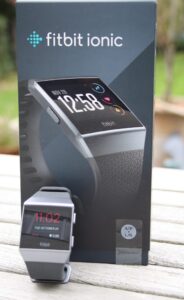 In The Box
In The Box
In the rather large box you get, the Ionic Watch, a proprietary charging cable and both sets of wristbands (large/small).
Not in the box, but also included for free, is the Fitbit health & fitness system aka apps/website that works on just about every platform…yes even Windows10 and the iPad.
Headphones/Earbuds are NOT included.
Fitbit recently released the FLYER headphones which will be your best bet to reduce any chance of generic headphones not working.
Here are some close-ups of either side of the watch and a detail of the strap mechanism. Although one spare set of straps is included, if you think about it you can mix the large with the small to make a medium set. Genius.
Comparisons & Specs
This section is for the undecided amongst you and for the seekers of geeky tech-details.
Key Comparison – Apple Watch 3 & Garmin Vivoactive 3
- Aesthetics: The Ionic’s aesthetics are better than I thought they were going to be. Certainly better than Garmin’s Vivoactive 3. It’s a better-made watch than the Garmin too BUT Apple’s watch, whilst visually quirky, wins on aesthetics and build quality. The user experience of all 3 is also filled with individual quirks, I guess once you get used to each one it will be fine after a few days.

- App Store: Garmin’s app store is sport-focused and improving. Apple’s app store is immense and getting more immense;-) The Ionic’s app store is in a fledgeling state BUT WILL probably grow to quickly be larger and more varied than Garmin’s.
- Battery Life is closely linked to screen display and GPS usage as well as to, err, battery capacity. The Apple will always struggle here but the v3 Apple Watch now makes a passable attempt. Garmin is way out in front with battery life and Fitbit’s Ionic makes a sound play at 4 days. When you consider the Ionic’s awesome screen, that’s good.
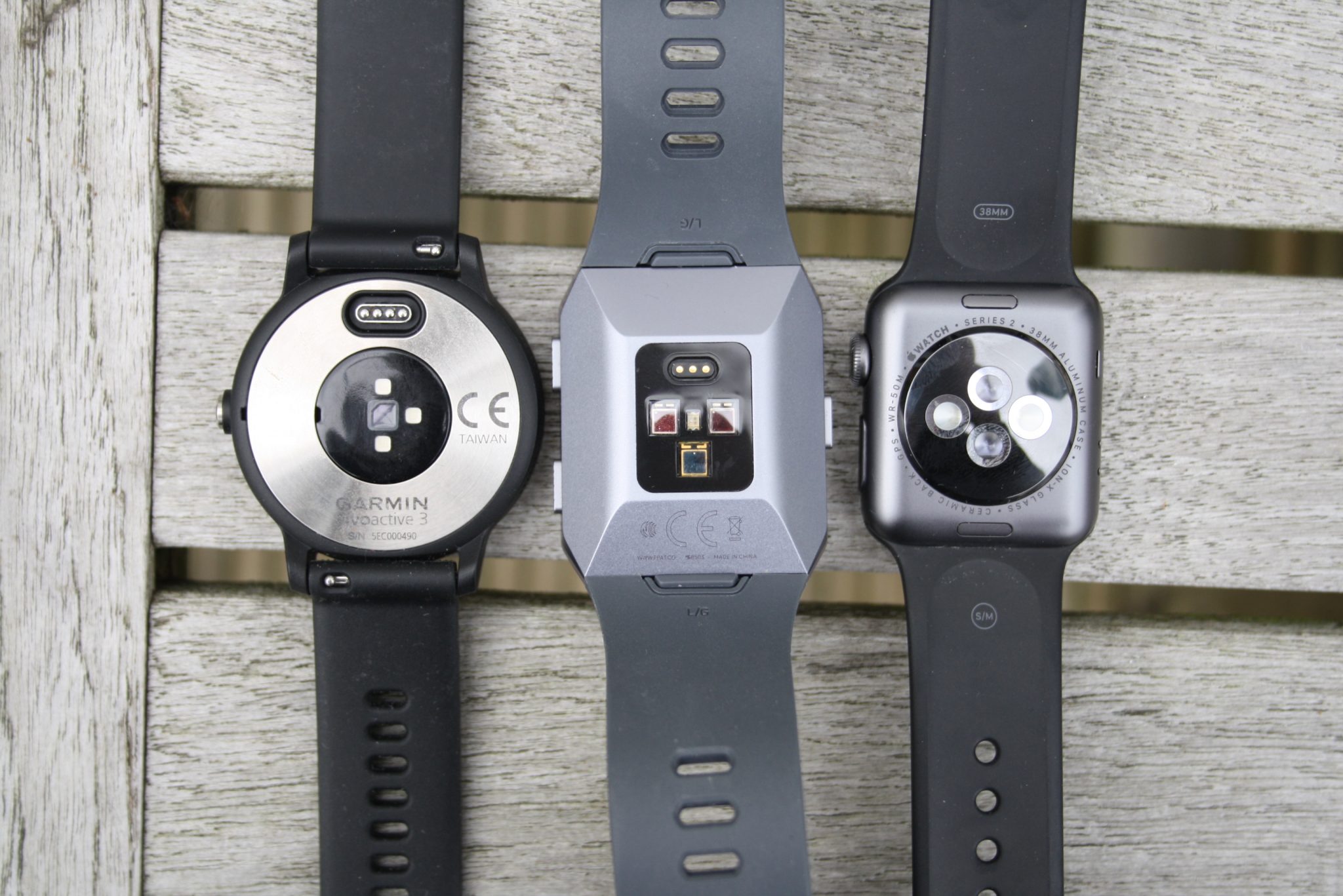
- Onboard Music – The Apple Watch 3 can properly stream music over an inbuilt cellular link. The Garmin can’t do music at all, other than to control what is on your smartphone. Fitbit make same the music play that TomTom made over a year ago, namely to copy tracks from your computer or from the Pandora service

- Payment System – Both Garmin and Fitbit have a MASSIVE game of catch-up to play here as their service is slowly rolled out across numerous global financial providers. Neither Garmin nor Fitbit will work for most of you in 2017.

- All the other techy stuff in these 3 devices is relatively similar and covers most people’s needs. The generic health, sleep, activity and sporting capabilities are similar for most people and, in each case, can be/will be augmented by apps.
The more sporty amongst you will buy the Garmin. The more image-conscious, trend-followers will buy the Apple like everyone else. Maybe the Ionic offers a slightly better, more practical and all-round compromise package?

Historical Comparison – Fitbit Surge & Blaze
My Fitbit Blaze went walkabout many moons ago which is a shame as it would be good to compare its similar looks.
I still use the Surge from time-to-time and always revelled in Fitbit’s overall ability to ‘just work’. Anyway, just look at the following images; they are indicative of Fitbit’s massive strides forward with the Ionic.
Sporting Comparison – AndroidWear
Apple, Garmin and Fitbit have their own platforms as do Samsung. However, Google’s angle is entirely different as they offer an open platform for hardware from any vendor (AndroidWear). Consequently we have seen 10s of new entrants building, essentially, either sports-watches or dress-watches on AndoirdWear. I don’t profess to know all of the dress-watches but the best of the sporting ones appears still to be Polar’s M600 (review here).
With the M600, Polar has a superior hardware offering to the Ionic for sporting usage. You might not like the overall looks of the M600 (I do) but it’s a serious sporty performer. Although even then, a dedicated sports watch (eg Polar, Suunto or Garmin) will in many cases be ‘better’ for sports than the M600 with more features, wider accessory support and a longer battery life. Although such sports watches would be nowhere near as smart as the Polar M600 with its wide range of AndroidWear apps.

Ionic Options
There are 2 shades of grey/gray and a copper-coloured watch unit. There are a variety of interchangeable bands of varying degrees of quality. A fourth model, produced in conjunction with Adidas (apps/branding), will surface in Q1.2018 and was leaked a month ago (link to: the5krunner.com).
The bands supplied are ‘industrial’. They ‘work’ but check out the options…
Ionic Key Capabilities & Specifications
Fitbit’s Ionic is a well-specified smart sports watch.
Whether or not that translates into a meaningful user-experience is another matter entirely. However it h,as the necessary bits of hardware to be continually improved by changes to software and apps. So it’s starting in a good place.
The screen is WAY better than the Garmin Vivoactive 3 and the battery life is better than the Apple Watch 2, although the Apple Watch 3 is improved on the AW2.
Fitbit Ionic attempts to track all the key elements of activity and sleep ranging from stairs climbed through to per-second GPS & optical HR (OHR) recording of your sports.

Here is what it can do
- Track steps, distance, floors, active minutes & calories burned
- Get friendly reminders to reach mini-goals of 250 steps per hour
- GPS/GLONASS to track pace, distance & routes
- Track Swims, lap count, duration & calorie burn. Water-resistant to 50m
- Automatically track exercises like sports & aerobic workouts
- Use continuous heart rate tracking & real-time zones with a snapshot of your cardio fitness level in the Fitbit app
- Guided Breathing Sessions – Start personalized sessions based on your heart rate
- Sleep Stages – Track time in light, deep & REM sleep stages
- Stores & Plays Music, 300+ songs, plus access Pandora, no phone needed, Bluetooth Headphones
- Smart Notifications, call, text and calendar notifications
Here are the components that enable the Ionic to do it
- Screen: Corning Gorilla Glass 3 covering 1.42″ inch 348 x 250-pixel screen with amplified brightness up to 1000 nits
- Sensors & Components: Altimeter, 3-axis accelerometers, Digital compass, GPS, Optical heart rate (OHR) monitor, Ambient light sensor, Sensors & Components, Vibration motor
- Lithium-polymer battery: up to 5 days with a GPS battery life up to 10 hours. 1-2 hour recharge every 2-3 days
- Memory: Saves 7 days of detailed motion data – minute by minute; Saves daily totals for past 30 days; Stores GPS & heart rate data at 1-second intervals during exercise tracking and at 5-second intervals all other times;
- Syncing: to a computer via charging cable, smartphone via Bluetooth (200 tested devices) and/or via WiFi
 Specifications are all well-and-good. The reality of real-life usage CAN be another matter entirely. For example, no wrist-based device will properly track sleep cycles to Polysomnography (PSG) levels of accuracy for MANY years. For example the battery life is UP TO 10 hours but what does that mean in reality? It might store 300 songs but that’s not so many AND it will depend on the level of compression in your music files. It might store per second GPS and OHR data for your sports but if the sensors are rubbish then the stored data will be rubbish…albeit accurately recorded rubbish.
Specifications are all well-and-good. The reality of real-life usage CAN be another matter entirely. For example, no wrist-based device will properly track sleep cycles to Polysomnography (PSG) levels of accuracy for MANY years. For example the battery life is UP TO 10 hours but what does that mean in reality? It might store 300 songs but that’s not so many AND it will depend on the level of compression in your music files. It might store per second GPS and OHR data for your sports but if the sensors are rubbish then the stored data will be rubbish…albeit accurately recorded rubbish.
We will cover some of these ACCURACY ISSUES later on in this review
Specification Source: fitbit.com
General Usage
A turn of the wrist and the beautifully vivid colour touchscreen jump into action after a relatively small delay. There are several pre-supplied watch faces and A FIRST FOR SMARTWATCHES !!…MANY of them are actually quite nice. Like this one.
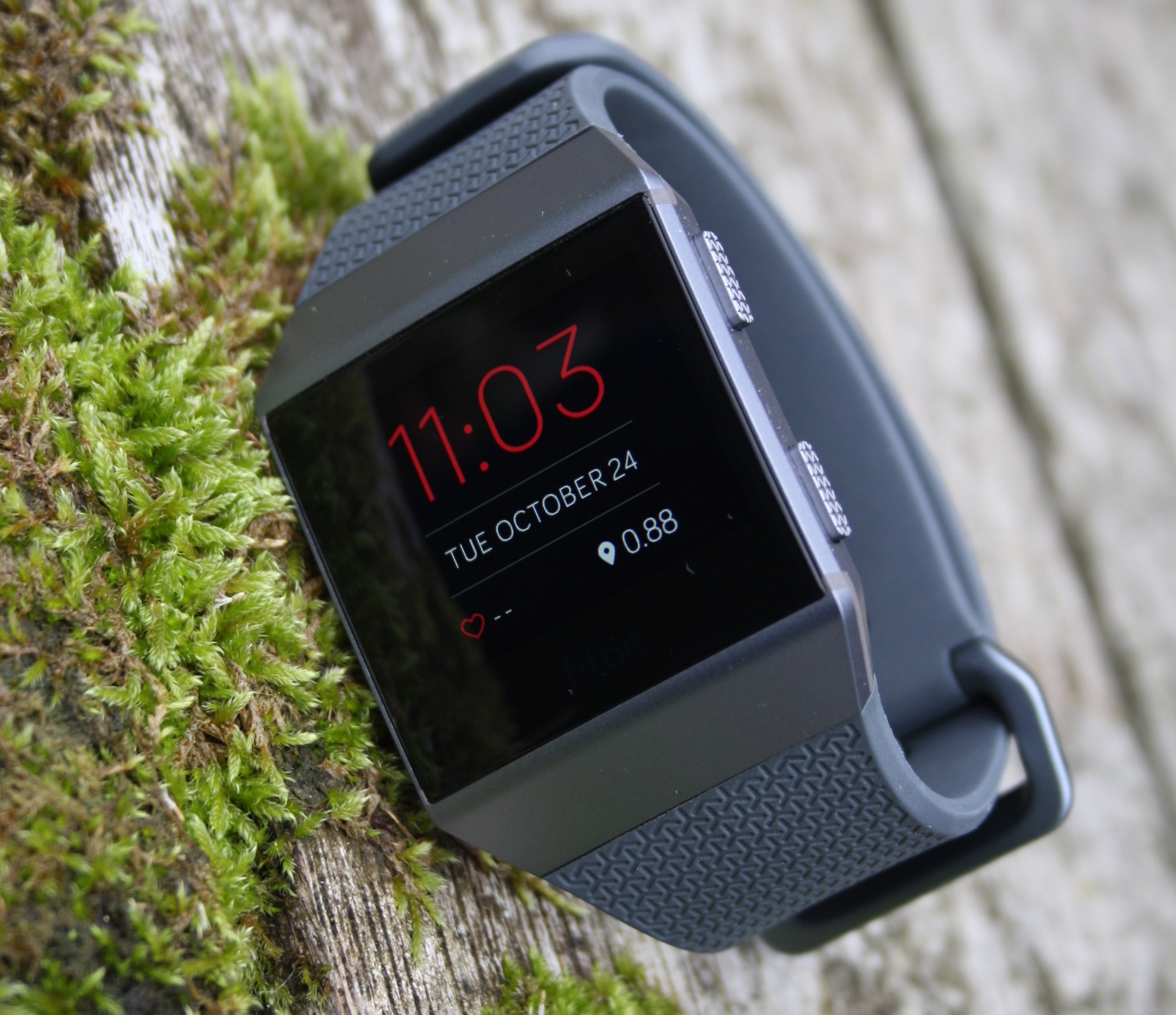
Generally, BUTTON LEFT goes back and ‘tap-the-screen in a particular place’ performs some action or other.
BUTTON TOP RIGHT is your Today app summary of activities. It also ends and saves a workout.
Look at the image below. At first glance, the Today app just shows the usual stats. But LOOK CLOSER. Yes, I’ve achieved my activity for 5 of the last 9 hours but the little dots tell me which hours! Similarly, the circled footsteps indicate progress towards Today’s goal.
The Ionic has lots of those little details everywhere. REALLY nice touches.
The BUTTON on the BOTTOM RIGHT directly accesses the exercise app…run, swim, bike, workout,etc.. You can choose your own sports and there are several pre-customised screens for each sport. The image shown to start each sport is a bit tacky IMO but it does demonstrate the nice quality screen.
SCREEN SWIPE IN from LEFT shows only two settings (notifications and screen wake) which is a bit strange. No doubt that will expand into something more exciting in the future.

Here is where it gets more exciting. SCREEN SWIPE IN from RIGHT gives the apps. Music, coach, wallet, weather, exercise (again), Today (again), settings and I installed STRAVA there too. All your selected apps will appear here.
Specific Usage – Sports, Fitness & Activity
You choose your sport from the ‘obvious pictures’ shown above 😉 You can then just GO. Or set some options like GPS or determine which metrics go on which part of which sport screen. The metrics are relatively limited but cover the basics like pace, HR , calories and the like.
Here are two very exciting images of vibration alerts and the status of FPS. All good stuff 😉
Here are examples of screens you see during your workout. Very exciting…but functional. And I have to say the clarity and size of the screen are GREAT for in-workout usage. The poxy 38mm Apple Watch is a wee bit small in comparison. Let’s hope your eyes are good if you go for Apple.
Specific Usage – Music
Maybe you would like to use Spotify?
Well you ,can’t. You can only use the Pandora service and that only works in the USA, for now, with Fitbit. Fitbit assured me that, for you lovely Americans, the Pandora links work really well. REALLY well. I couldn’t test it tho :-). There are links and rumours that Spotify support will be added ‘soon’.
Fear not you can retrieve music from your computer. Any review that glosses over this and tells you how wonderful it is hasn’t done it in reality and they are just rehashing the manual to you.
It DOES work. But it ain’t easy folks. At least on Windows Media Player (WMP).
Honestly, Fitbit support advised me all of the following must be simultaneously enabled: Bluetooth link from your PC (old versions of Bluetooth might not work); WiFi link to the internet must be set up and working (yes even for the WMP transfer); you need the Fitbit software installed on the PC (but not the Windows 10 PC app as that doesn’t always work); you need the charging/transfer cable to attach the Ionic to the PC.
This is where I try to look cool with my music selections. Hence the A$AP Rocky transfer unfortunately you can see it’s waiting until The Music from the OC has downloaded and Amy Macdonald is already on the Ionic. The transfer process quotes ridiculous transfer times of about one hour per albumn over a Bluetooth USB cable…luckily it’s much quicker in reality. Phew.
But not all playlists are created equal. Some transfer and some don’t. Possibly WMP’s auto-playlists don’t transfer. At the point of trying to figure that one out, I lost the will to live and resigned myself to running to Amy Macdonald for the next two weeks. At least that should make me run faster to get me home quicker 😉 Sorry Amy. You’ve done some good tunes.
Next of course you will need to pair your potentially pesky Bluetooth Headphones. I have some Jabra Sport Rox and they actually paired first time.
Amy’s “4th of July” really did sound like an awesome quality recording. Of course the quality of what you hear comes from the quality of your audio experience is governed in large part by the digital recording (ie lossless/lossy) coupled with the digital-analogue conversion that takes place in the headphones.
Specific Usage – Fitbit Pay

Well, you can hold your Ionic as near to the Reader as you like.
No really. Hold your card next to the reader AFTER you’ve pressed the button.

Nothing will happen until 2018. You’ll get hungry if you are buying food.
All the reviews that show this working either have special pre-paid cards or are customers of the few American banks that have so far negotiated an agreement with Fitbit. Your bank will likely not work until 2018.
It will eventually work. Fitbit have to make it so as a matter of urgency and they know that. I’ll update this section when it works for tiny, little First Direct (HSBC) in the UK. They will probably do the big banks first like, errrr, HSBC. ?!? Nope.
The first supported UK bank is STARLING…really? Who? (Source: starlingbank.com). In the interests of doing something new, I opened an account. 10 minutes later it was done. 5 days later I got a card. 5 minutes later I had £10 on the card and hence on the Ionic. Ready to go. (NB: I couldn’t make Fitbit’s wallet work on Android but it did work on the supposedly unsupported iPAD Fitbit app…that will take 10-30 minutes)

Next a trip to Starbucks. Lattetastic. It works!
Maybe you should buy the Garmin Vivoactive 3 instead? Nope. That will be the same. If contactless payment over NFC is important to you NOW then you buy the Apple Watch or something that supports AndroidPay. Or open a Starling Account!
USAGE: You press and hold the left button after unlocking the watch with your pin. From what I can see the PIN is mandatory once you have a wallet set up. Release and then put near the shop’s reader to authorise the next single transaction. It will be MUCH quicker than paying with a card and pin number and faster than paying by cash and waiting for change. On the downside, I had to nearly dislocate my shoulder to get the watch at the correct angle to enable it to give payment.
OFFICIAL INFO: All the latest Fitbit Pay status is given here (link to: Fitbit.com).
Specific Usage – Apps
The Ionic comes with a series of standard pre-loaded apps. Things like ALARMS and WEATHER count as apps rather than inbuilt functionality.
Before the holiday selling season (2017) we’re going to have a full-blown launch of the Fitbit app gallery, which is going to be a combination of some new first- and second-party apps with select partners, beyond with the ones that have already launched, along with opening the floodgates to opening submissions to third parties
Source: Fitbit CEO
Initially, all I could really find was a token STRAVA app. But the number is growing.
Fitbit Ionic & Versa Apps – From Pregnancy Planning to Nest to NYT.
There are also now community leaderboards for your sporting challenges and additional watch faces AND a pill tracker.
STRAVA APP
The STRAVA app requires authorisation to your STRAVA account but then shows a summary of your recent exercises, including those not recorded by the Ionic. You can also see a line map of your recent exercise as well as a nifty graph of your trend performances over courses you repeatedly complete.
My concern with the Fitbit ‘app store’ is that we have the Apple and Google app stores and they work in a broadly similar way to each other which we all understand. This wheel doesn’t need re-inventing.
COACHED Workouts app
This is cool…ish. i don’t think I’ve quite seen anything like it before. Probably because previous devices, including the Apple Watch, have not had a sufficiently large screen that can run a decent resolution. The Ionic can.
There are a few workouts and you are coached through a series of exercises and even get included a ‘sort of’ video showing how to do them. There are also pretty notes saying which parts of your body are being worked on.
The COACHED workouts are accessed through the app with the STAR icon. So this is “Fitbit Coach” which is part of Fitbit’s Fitstar acquisition from a few years back. No doubt as things progress you will be encouraged to add new COACHED workouts from the premium Fitstar service that exists within Fitbit’s existing infrastructure. Here is a link to the currently separate Fitbit Coach app.
WEATHER APP
Weather at multiple locations. You’ve seen it on your smartphone from a provider like AccuWeather, well now you can see the weather of just about anywhere in the world.
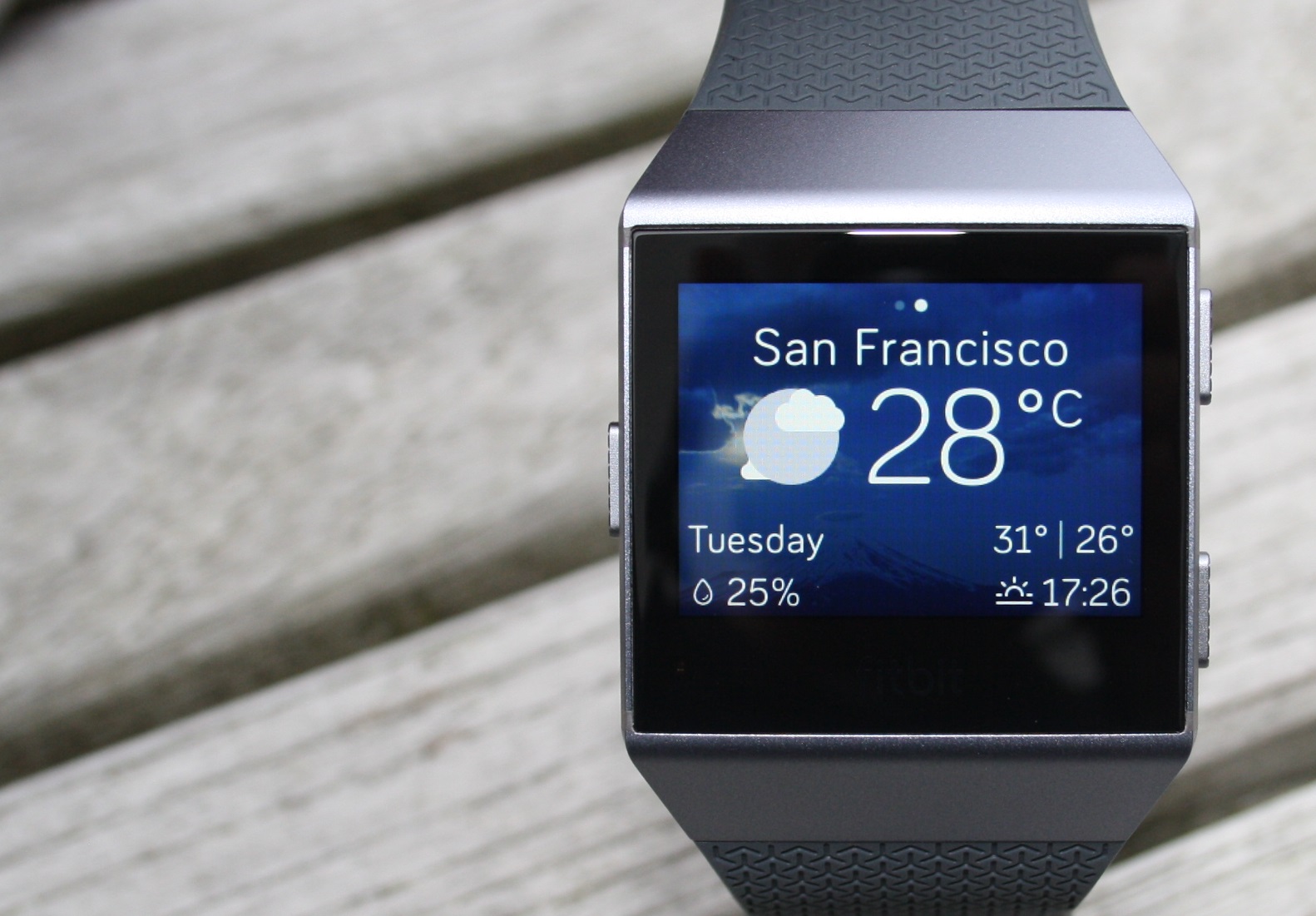
The Fitbit Ecosystem
I remember Fitbit’s software as always being thought through and intuitive. And, more importantly, always working. Well…more than most 😉 It seems to be more complex than I imagined but it is still as open as it ever was and will work on just about any vaguely recent device you have.
I don’t want to dwell on this too much, so here is a slide show giving an indicative view of the various insights and trends. The screens look at: the overall dashboard; daily and trending 247 heart rates; daily and trending sleep. It’s good.
Clockfaces in the Fitbit Ionic Review
As I think I said earlier. Some of the clock faces are actually nice. Ta Da !! Take note Garmin. All you need is a half-decent screen and some imagination.

Accuracy
A sports/fitness watch needs to have a reasonable degree of accuracy to provide useful feedback and support any guidance give.
Acuracy GPS
The Fitbit Ionic’s GPS is broadly OK for the kind of purposes it’s intended for. For example, as a general running watch, it is fine. However, a more serious athlete would probably want a little bit better accuracy.
GPS accuracy is the building block for how the Ionic gives speed, distance and a pretty post-run track on a map.
When I put the Fitbit Ionic through my GPS test – methodology and raw data files here (link to: the5krunner.com) it scored lower than I thought it would at 67% which is just below the Fenix 5X (69%). The Vivoactive 3’s result (73% in adverse wear position) and the Apple Watch’s result (75%) were both better. Although I have had a few sources suggest I re-test the Apple as it doe snot have a consistent performance.
The Ionic’s accuracy in easy conditions, eg open parkland, is good. It just struggles a little bit when there are buildings and tree cover. Although in this first example it does fairly well in a difficult scenario.

But on a different day you can see here the Ionic (blue) easily tracks a tree-lined path well, whereas the Vivoactive 3 (red) struggles.

Here is another example compared to a Suunto AMBIT 3 RUN (BLUE). This is hard GPS territory!
- The circled section is a long tunnel where both devices are just guessing where I ran. What I am interested in is how quickly GPS is re-acquired when starting to run over the bridge. The Suunto appears to do it almost immediately. Other devices at this same point have failed to find a signal for many, many 10s of metres.
- Before the ‘Horse Fair’ tunnel the Suunto is nearly exactly following the route I took, certainly to within 5m. Superficially the Fitbit appears to follow a ‘similar-looking route’ but in actuality it is struggling – as an example I would score the Suunto 3/4 and the Fitbit 2/4 (forget the tunnel).

I could find examples of good and bad performance from my numerous workouts. Overall my formal test result of 67% seems a little low and I will give it another chance or two.
Accuracy – Optical Heart Rate
The Fitbit Ionic’s heart rate accuracy is generally fairly good for an optical HRM. Please appreciate that optical HR accuracy can be good but will vary from person to person and from sport to sport. Endurance runs and stationary bike training tend to allow good oHR performance but every other exercise is prone to errors mainly due to high or rapidly changing heart rate levels and wrist movement. If you are buying an optical HR watch please NEVER EXPECT accurate results in sport. If you’re lucky, you might get them.
As found on several optical devices, there can be unusual levels at the start of exercises and then the oHRM settles down to the ‘correct’ level. Here the Ionic does that and after about 6 minutes perform well. Of particular note is the Green line which is also bad at the start. This green line is the supposedly accurate Garmin chest strap – I’ll have to check the battery (although the battery is one month old). Garmin’s Vivoactive 3 nails this run, that’s an optical HR device too.

Getting rid of that pesky Garmin HRM-TRI strap and using a new one we get much the same kind of picture. This time we look at a much longer run with a relatively constant and lower level of aerobic intensity. The garmin is marginally better than the Ionic. The Garmin only has one trough and the Ionic is a bit spikey. This is a pretty good performance for optical HR. Nice job Garmin+Fitbit (note I can’t also wear a 3rd optical device like the Apple Watch as multiple optical signals on one arm will likely cause errors).
Lets take our running shoes off and go cycling. Normally I expect to see variable results from optical HR devices. I wasn’t surprised with the results. The Ionic had a moment of HR madness at 42 minutes but other than that was broadly OK with the Vivoactive 3 being unacceptably poor. This was not surprising as, in my experience, Garmin tend to have much better running+ohr performance than cycling+ohr.
I can add some more charts here if anyone wants to comment below eg for HR performance during workouts or swimming.
Accuracy – Steps
Walking Steps are notably lower on the Fitbit than on the Garmin. 25% lower. This is strange as Garmin walking steps are normally fairly accurate.
However, when running the Fitbit is closer (15100 vs Garmin’s Vivoactive 3 at 15900). Indeed I checked the Garmin and Fitbit against a footpod-recording of the same route and the footpod recorded approximately 15180steps. So the Fitbit might be more accurate than I originally thought.
On a daily basis over a week, the Fitbit seemed broadly consistent with my activity levels and so it will be perfectly fine for those of you who just want to record steps, stairs and the like. Perhaps not directly comparable with your previous device which may, or may not, have been ‘accurate’ in the first place.
Accuracy – Sleep
Here is Fitbit’s analysis of one night sleep and following on from Fitbit’s analysis is an analysis from EMFIT. I would consider the latter to be the ‘best’ sleep tracker.

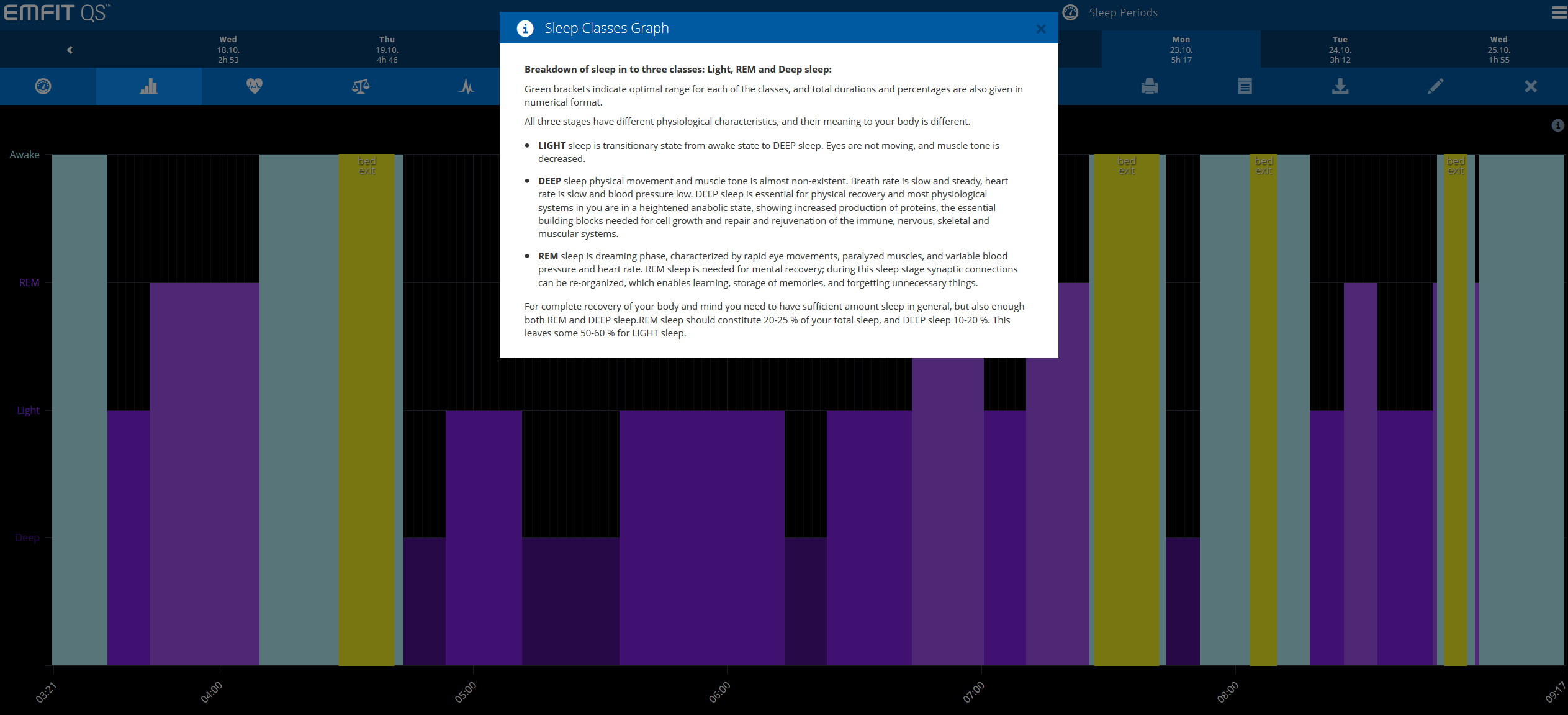
You can, perhaps!, see that there are broad similarities. But the reality is that they are different. The reality is that neither are ‘correct’.
EMFIT uses accurate heart rate modelling and more complex modelling of whole body movement, whereas Fitbit will use less accurate heart rate modelling coupled with wrist movement.
Accurate sleep tracking is for the world of sleep scientists with special laboratories. We can only get indicative insights into our sleep patterns. QS EMFIT (review here) and OTHER Ring are the most accurate you can get if you are particularly interested in sleep analyses and the former have products targeted at athletes as well as people with specific sleep conditions.
Best Running Watch?
Clearly the Ionic will never rank as the ‘best’ running watch. It hasn’t been designed to do that. BUT it could rank highly as ‘the best smart sports watch‘ or maybe ‘the best smart running watch‘. Maybe.
Have a look…
Best Running Watch 2022 | Top 10 Garmin, Apple, Fitbit, Polar Comparison
Sensor Support
Nope. None of that.
No Bluetooth or ANT+ sensors are supported.
Summary & Recommendations
I’ve run well over 50 miles with the Ionic for this review and cycled a lot further than that. It’s left an indelible imprint on my mind as well as my wrist.
Having bought the Ionic myself I have no axe to grind with Fitbit’s PR team either way. I expected the device to be super slick and highly competent but just a little bit ugly. The realities were different on all counts.
If you want to upgrade from an ealier Fitbit then you will be mightily impressed on the whole. You love all-things Fitbit. Just do it. Get that Christmas present list out and write IONIC in BIG capital letters. Sorted.
If you are not sure about the looks then I’d urge you to see one in the flesh as they do look and wear much better than you’d imagine.
The practicality of the device edges it over the Apple Watch in my personal opinion. We’re talking battery and a decent-sized screen. The two both have high-quality looks and build although the looks and number of supported apps are clearly different.
 The Vivoactive 3 easily beats the Ionic if you take sport seriously – although I’d be questioning why you are not buying a ‘proper’ sports watch. However, the Vivoactive 3, whilst new to Q4.2017, is extremely dated in its looks and lacks in build quality. Sure the battery will last a long time and you will be able to connect many sensors to it but you will be a little embarrassed to wear it. It looks cheap for the money.
The Vivoactive 3 easily beats the Ionic if you take sport seriously – although I’d be questioning why you are not buying a ‘proper’ sports watch. However, the Vivoactive 3, whilst new to Q4.2017, is extremely dated in its looks and lacks in build quality. Sure the battery will last a long time and you will be able to connect many sensors to it but you will be a little embarrassed to wear it. It looks cheap for the money.
For my sporty friends, who are a little less sporty than me, then the Ionic is great and the Fitbit app/web is great too. It’s smart enough as a smartwatch but is still at school being educated. It will get smarter soon, probably graduating in early 2018.
When I used the Ionic in anger ‘it worked’. The issues I had were in getting its individual aspects set up. These WILL be ironed out soon. ie The key features of music, payments and apps all work but they need improving and expanding. The sporty stuff and the activity stuff looks nicely sorted to me.
The Ionic will NOT be an Apple Watch killer. But it may well be Fitbit’s saviour. The biggest loser of the 3 key players will probably be the Garmin.

Price, Discounts & Availability
Hopefully you enjoyed the review as well as finding it helpful in your decision-making process.





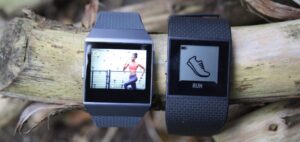
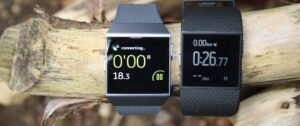








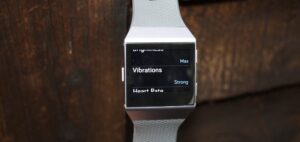











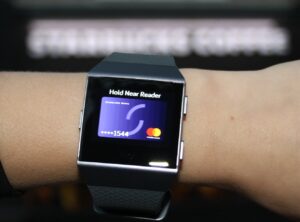




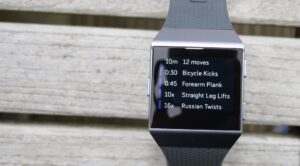










I’ve been meaning to get here and comment on this. Super job here, but I wanted to share my experience with Fitbit.
A couple of years ago I started to get myself back in shape. After my initial training period (2013) I went in on a fitness watch. At the time, Fitbit was glued to everyone’s eyes and decided that the Surge was the right fit for what I did, and what i’d do, and, it was. The ease of use, the simple app and the slew of new metrics was exactly what I needed. I used it for walks, for runs, for biking, for workouts. The GPS for me was on point (it actually is still the most accurate i’ve seen on a watch in my neck of the woods) as was the interface and activity tracking (not to mention getting phone messages/text etc..) The only thing i’ve ever found that was wrong were steps; which were always way overboard, we’re talking near 10k steps wrong at worst. I find funny that the Ionic (the evolution of the Surge in many ways) is under-reporting. Yet for everything that came with the Surge the one thing in hindsight that stood out (and still stands out)
The Optical Heart-rate Monitor.
That OHRM has been, in my experience, the most consistently accurate piece of tech i’ve ever come across. I used that thing for every type of work including workouts with weights that included dynamic movements, i’m talking extreme muscle flexion and that little sensor was never south of 90% accuracy. Of course I didn’t really understand this until I moved onto Garmin and their Forerunner 235; then the differences were glaring. Workouts I had done with the Surge now looked ridiculous on the 235, like 100 bpm less than I had just done. At first, I thought it was the Surge. Maybe it was over-reporting all this time? It wasn’t until I tested that accuracy that I found the Surge wasn’t the problem, it was Garmin’s OHRM.
To test it, I wore the Surge on one wrist, the 235 on the other and a chest strap connected to an app on my phone. I also did this over 2 days switching the watches to the other wrist to see if it made a difference (it didn’t). On both workouts, the Chest-strap and the Surge were within a beat or two of each other…the 235? 111 bpm lower than either. At that point I almost just returned the 235 (I eventually did….3 times!) and went back to the Surge, but I stayed because I realized that I could just use a chest-strap instead and other sensors with the Garmin watch that gave far better accuracy…and more metrics than Fitbit did or could.
That’s the thing for me: Garmin and those in this sector offer more data (that I want and need) than Fitbit does. Not only that, but sensor support with said data far outweighs one great sensor without much to it any day. Even so, the Ionic is calls to me because of how accurate the Surge was. If Fitbit wants to broaden there base a tad…more metric tracking (without an absurd yearly subscription) and external sensor support. For me, Styrd support is a must, even chest strap support (though in my opinion it would be the only time I wouldn’t find it necessary), not to mention bike comp and power meters. I know this means it basically is a Garmin….but why? Fitbit’s ecosystem is more about people with friendly support and social interactions right?
That’s the backbone of Fitbit. Garmin has these things, but it’s ecosystem is cold, sterile feeling. To me it’s an afterthought for Garmin while that could be the defining characteristic of Fitbit, even moreso with with Running metrics etc…Fitbit’s OHRM to me is best on the market. Not Valencell, or Polar or Garmin; Fitbit’s is usually on the mark, though Apple’s apparently smokes them all? Still the Ionic is not a dud, I just hope they extrapolate off this and grow upwards here. They don’t need another alta or charge. They just need to go further with the Ionic.
thank you for those comments I will bear them in mind.
i’m still doing stuff with the ohrm on the ionic. my ‘feel’ is that it’s not as good as your experience. but I have a little bit more to do …..
My Wife’s Alta HR died recently, and I wanna get her a new tracker. All she cares about is sleep tracking, 24×7 HR, and workout HR (she rows daily). She doesn’t need any workout modes or other functions than the aforementioned. She prefers the form of a tracker, and it needs to come in rosé gold, with the latter being more important, which allows something like the Ignite (comes in rosé). WR is a plus but not mandatory.
What’s the best gadget right now on the market for sleep tracking? Ionic? Charge 3/4? Ignite/Unite?
Thanks T5R
Edit: Posted this under the wrong article!
c’mon. fess up. It’s for you really isn’t it 😉
Q: “What’s the best gadget right now on the market for sleep tracking?”
oura ring.
qs emfit.
taking into account reporting as well then you could go for a Polar. ignite comes in rose gold, get an oh1/verity for rowing,
| But then you add in hr and rowing so you come back to a more serious device if you want to measure activity.
or apple watch 3 as daily tracker, put it on charge overnight, wear oura overnight. wear oh1 for sport. link polar flow and oura back to apple health
so oura + oh1 (row). but then you miss out on the 247 hr but you get potentially 2 sources of readiness in return, which is more useful
i rarely look at the tracker bands, haven’t for a few years.